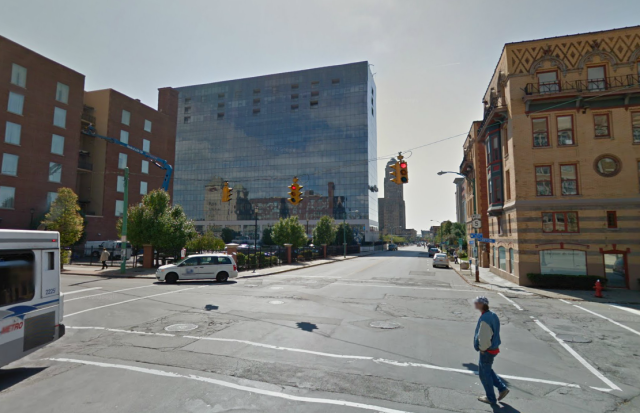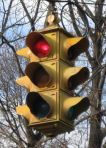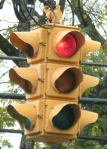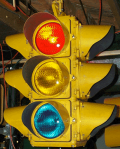 The image above, like many of the photos that will be featured on this site, was taken from Google Maps. It is the corner of S. Elmwood Ave. and W. Chippewa St. There is quite a contrast between the classic Crouse-Hinds “Art Deco” traffic signal and the recent Avant Building as its backdrop. It would be impossible for me to go out and photograph these signals myself, because they are no longer there. About a year ago, they were replaced with brand new, generic traffic signals mounted on mast-arms. Most people wouldn’t think anything of this, but in its own way, the loss of these signals was significant. The signal in the middle was one of only three remaining Crouse-Hinds “Art Deco” fixed 4-way signals in the city of Buffalo, and the last one in regular service with its original glass lenses.
The image above, like many of the photos that will be featured on this site, was taken from Google Maps. It is the corner of S. Elmwood Ave. and W. Chippewa St. There is quite a contrast between the classic Crouse-Hinds “Art Deco” traffic signal and the recent Avant Building as its backdrop. It would be impossible for me to go out and photograph these signals myself, because they are no longer there. About a year ago, they were replaced with brand new, generic traffic signals mounted on mast-arms. Most people wouldn’t think anything of this, but in its own way, the loss of these signals was significant. The signal in the middle was one of only three remaining Crouse-Hinds “Art Deco” fixed 4-way signals in the city of Buffalo, and the last one in regular service with its original glass lenses.
The goal of this blog is to highlight the classic traffic signals that remain in Buffalo, to possibly open the eyes of some who have never paid any attention to traffic signals, but most importantly, to serve as an archive to document these signals before they are gone.
The Plan: Initially, I intend to document all remaining intersections with “Fixed 4-way” traffic signals in Buffalo. I will accomplish this through the use of Google Maps Streetview images, in order to quickly capture each intersection before any other signals are replaced. Once this first phase is completed, I will feature other interesting, old signals in Buffalo that do not fall into the fixed 4-way category. Along the way, I will add original photographs of signals both present and past, including a number of photos that I took in 2002-2003 of signals that no longer exist.
What is a “Fixed 4-way” signal? It is the old-fashioned, clip-art, cartoon-style traffic signal that many of us grew up with. Essentially, it is a single unit that controls 4 different directions of traffic. There were several different manufacturers who produced fixed 4-way models of their signals until the late 1960s. Of these, only Crouse-Hinds and TSI signals are represented in Buffalo. There are many other interesting signals in Buffalo produced by manufacturers such as Marbelite, Eagle, GTE, and Winko-Matic, but none of these are fixed 4-ways.
The Crouse-Hinds Model DT, or “Art Deco” signal is the oldest and rarest, being produced in the 1940s and 1950s. It is nicknamed “Art Deco” due to the domed detailing at the top and bottom of the signal, as well as other ornate detailing that appeared on the single-face version. There are only a small handful of these remaining in service. Its replacement, the Model M, was produced from the Late 1950s through the Late 1960s. These are more common, but quickly disappearing. Though the Model M 4-way does not have a nickname, the single-face version is nicknamed the “Breadpan,” due to the shape of the signal’s back. When Crouse-Hinds replaced the Model M with the Model R around 1967, they did not produce a fixed 4-way model.
The other fixed 4-way signal that appears on the streets of Buffalo is manufactured by TSI, or Traffic Signals Incorporated. These can be spotted immediately by the distinctive shape of their visors, as well as the small gap between the visor and the lens. The single-face TSI signals are even more distinctive, with a unique sculpted back. There were a number of companies that came before and after TSI, producing signals of a similar design. In Buffalo, the majority of these signals were installed in the 1960s.




Wonderful that you pay such close attention to traffic signals. One of my pet peeves is the replacement of the signals hanging from cables to lights attached to heavy cross arms attached to poles. This heavy hardware is much uglier than the more delicate wires. I have been told that the cross arms are much more reliable. I wonder if there is any data to back up this contention or is it simply done in order to spend money.
Daniel, thank you for visiting the blog. I am not sure that the signals on mast arms are really that much more reliable than those on span wires. I have rarely seen a signal fall down from a wire, even with our severe weather conditions. Mast arms are certainly not universally used, even in the WNY area. If you take note, most of the suburban roadways still have signals suspended from span wires. I think the mast arms just caught on with the City of Buffalo in the 1970s, and have been used frequently (but not always) in new installations ever since. Rarely are signals replaced because they are no longer functional; it is usually as part of a larger roadway construction project where everything else is being replaced.
Some cities have actually made an effort to use traditional fixed 4-way signals in their historic districts, either older restored units, or signals produced by Teeco Safety, which still manufactures the traditional TSI 4-way signal design for special applications.
Ryan, thanks for posting the blog. Sadly the remaining fixed 4-ways seem to be disappearing. I was fortunate to get one of the TSIs and restore it, but I would have preferred it to have stayed on the street. Ironically a number of other cities are now putting vintage signals back on the street in their historic districts, albeit with new LED optics.
Ryan, I just would like to say this is a really cool blog and I thank you very much for posting it. In my opinion, it is nice to see there is someone out there besides me who still cares about these littler guys, especially the ones on wires. My main issue with the newer arm stand lights is that not only do a lot of them use the slightly bigger signals, a lot of them are set up in an almost square like fashion and are not set up at all similarly to the slightly more elaborate way as the wired littler guys they replaced. I also have a couple of, let’s call them, half statement half questions for you as well. I have seen your post on “Featuring South Park and McKinley” and I was very intrigued to learn that Walden Ave’s city stretch and Main Street’s University Heights stretch did indeed used to have some of those signals at various intersections and I am curious as to if you have more on those two roads. As well as that, I am also curious if you have anything on the entirety of Sycamore Street, the entirety of Fillmore Ave (especially from Best Street to Main Street), Genesee Street’s stretch from Bailey Ave to the City/Town of Cheektowaga line, and Hertel Ave’s stretch from Delaware Ave to Starin Ave as I have a very strong suspicion that there were some of those signals on those specific stretches but I am unable to find anything on that.